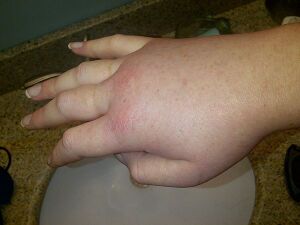Hereditary angioedema
Hereditary angioedema (C1 inhibitor deficiency, OMIM: 106100 ) is a genetically determined disease of the immune system with autosomal dominant inheritance. This is not a classic immunodeficiency , where the affected individual would be exposed to a higher risk of infectious disease, but it is a hereditary disease of the immune system, where a mutation in the gene for one of the components of the immune system damages its carrier .
Pathogenesis[edit | edit source]
The mutation affects the gene for the C1 inhibitor of the complement component (C1-INH, localization 11q11-q13.1). The product of the mutated gene is either not formed at all or is non-functional. This fact means that any (even if minimal and harmless, such as a minor injury) stimulus leads to the activation of the entire complement cascade , the increased production of bradykinin is responsible for the clinical manifestations , which is normally regulated by inhibiting the conversion of prekallikrein to kallikrein thanks to C1-INH.
Clinical picture[edit | edit source]
Externally, the disease is manifested by swelling of the subcutaneous tissue and mucous membranes , which are pale, non-itchy, without a local increase in temperature. Swelling of the mucous membranes of the respiratory tract can be dangerous , damage to the mucous membranes of the digestive tract can manifest itself in digestive difficulties , in a more severe form, pain and partial intestinal obstruction and mimic a sudden abdominal attack, in the case of damage to the mucous membranes of the urinary tract, there is a risk of urine retention .
The disease has a later onset, sometimes in adulthood.
Diagnosis[edit | edit source]
The diagnosis is based on the evidence of a low level of the C4 component of the complement (due to consumption) and a very low (in the case of a non-functional form of C1-INH and normal or high) levels of C1-INH .
Differential diagnosis[edit | edit source]
In terms of differential diagnosis, it is necessary to distinguish the acquired forms - paraneoplastic (consumption of C1-INH in the tumor tissue), parainfectious (rarely in Hellicobacter pylori infection ) and drug-induced (in ACEI therapy in up to 0.3-1% ).
Treatment[edit | edit source]
In acute treatment , B2R receptor antagonist for bradykinin − icatibant sc and iv substitution of C1-INH are used . Antifibrinolytics (tranexamic acid) and danazol (ethinyltestosterone derivative) are given as long-term prophylaxis
Links [ edit | edit source ][edit | edit source]
Related Articles [ edit | edit source ][edit | edit source]
Source [ edit | edit source ][edit | edit source]
- ŠIPEK, Antonín. Genetically determined disorders of the immune system [online]. Last revision 9/6/2006, [cit. 4/1/2010]. < http://www.genetika-biologie.cz/primarni-immunodeficiency >.
References [ edit | edit source ][edit | edit source]
- ↑ HAKL, Roman and Pavel KUKLÍNEK. Hereditary angioedema in theory and practice. Practicus [online] . 2015, year 14, vol. 5, pp. 9-10, also available from < http://www.practicus.eu >. ISSN 1213-8711.
References [ edit | edit source ][edit | edit source]
- BARTŮŇKOVÁ, Jiřina. Immunodeficiency. 1st edition. Prague: Grada, 2002. 228 pp. ISBN 80-247-0244-4 .
- GUTOVA, Václava. Current treatment options for hereditary angioedema. Remedia [online] . 2012, year 2012, vol. 6, pp. 393-397, also available from < http://www.remedia.cz/Clanky/Farmakoterapie/Soucasne-moznosti-lecby-projevu-hereditarniho-angioedemu/6-L-1oM.magarticle. aspx >. ISSN 2336-3541.

